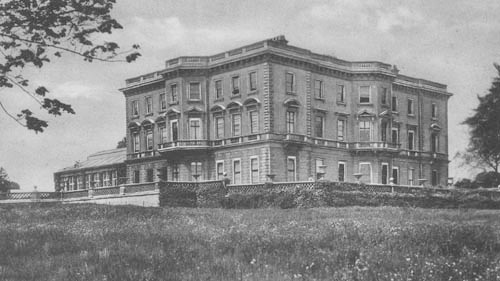Denbies [II]
Surrey
| Location | Ranmore | ||
| Year demolished | 1953-54 | ||
| Reason | Insufficent wealth | ||
| See all images: | Gallery | ||
| << Back to the main list |
Thomas Cubitt (later 1st Baron Ashcombe) was regarded as one of the best builders of the Victorian era – though to call him a builder is to underestimate his importance. Before the rise of the formal architect, builders often combined both roles very successfully. Cubitt rose from humble beginnings to royal patronage, building many of the most important central London areas and in the process revolutionising the building industry. Though he became a millionaire he only acquired that symbol of wealth, a country house, in the last decade of his life.
 Cubitt knew the area around Dorking in Surrey well as he had previously built the new house at Polesden Lacey. Having bought the Denby estate in 1850 Cubitt set about building a house worthy of his success. The existing Georgian house was considered small and the rooms inconvenient – though the grounds were well-regarded. So by 1854 a new house called Denbies - designed and built by Cubitt – sat above and slightly behind the old one which was demolished shortly afterwards.
Cubitt knew the area around Dorking in Surrey well as he had previously built the new house at Polesden Lacey. Having bought the Denby estate in 1850 Cubitt set about building a house worthy of his success. The existing Georgian house was considered small and the rooms inconvenient – though the grounds were well-regarded. So by 1854 a new house called Denbies - designed and built by Cubitt – sat above and slightly behind the old one which was demolished shortly afterwards.
Denbies was the product of Cubitt's lifetime’s experience of building country houses – including Queen Victoria’s favourite holiday home, Osbourne House on the Isle of Wight. In fact, so closely did Denbies resemble Osbourne House that a rumour circulated, though much denied by Cubitt, that Denbies was to be a holiday home for Queen Victoria’s eldest son.
The house was a three-storey Italianate-style mansion built in a similar pattern of Cubitt’s large central London houses. Nine bays wide on each side with the central three windows being part of a canted bay. The ground floor windows had 'Gibbs surrounds' whilst the first floor windows on the canted bays had triangular pediments with all others having segmented pediments. A balustraded parapet crowned the edge of the flat roof. Cubitt’s attention to detail was such that he had his own bricks made to build the house and, on demolition, the contractors discovered layers of seashells between floors inserted as rudimentary sound-proofing.
Shortly after he taken over Cubitt set about enthusiastically improving the estate with the planting of thousands of conifer trees followed by thousands of hardwoods. However Cubitt only enjoyed this fine house and estate for less than three years, dying of throat cancer in 1856 aged 68. Denbies passed through his sons until after World War II, when the house was billetted with troops and suffered from the usual neglect and damage. With insufficient funds to restore and run a house with almost a hundred rooms, Cubitt’s great-grandson (the 3rd Baron Ashcombe) converted the laundry and gardener’s house into a smaller Regency-style house and moved in. Denbies was demolished in 1953-54.
An article on the Epsom and Ewell History Explorer gives a more detailed insight into the lives of the Cubitt dynasty.